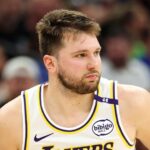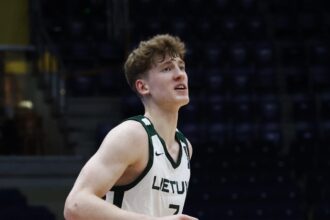The LA Clippers’ unexpected early exit from the 2025 NBA Playoffs has sparked intense debate among fans, analysts, and insiders alike. After a season filled with high expectations and marquee acquisitions, the team’s first-round departure has left many questioning where the fault truly lies. Was it a failure of coaching strategy, underwhelming performances from star players, or organizational missteps behind the scenes? This article dives into the key factors contributing to the Clippers’ playoff disappointment, aiming to separate fact from speculation and uncover who-or what-is really to blame.
Clutch Performance Failures Undermine Clippers Playoff Push
As the Clippers’ 2025 playoff hopes dissolved earlier than expected, a critical factor stood out: the inability to execute during the most pivotal moments. The team’s offensive sets sputtered under pressure, and defensive lapses in crunch time cost them leads they had painstakingly built. Key players, who had been reliable all season, struggled to deliver when it mattered most, raising questions about mental toughness and clutch preparedness. Despite impressive individual stats during the regular season, the playoffs exposed glaring inconsistencies that opponents exploited decisively.
Several issues converged to exacerbate these late-game breakdowns:
- Turnover spikes: Under pressure, ball security faltered, leading to fast-break points for adversaries.
- Shot selection woes: Forced, ill-timed attempts replaced high-percentage looks, draining momentum.
- Defensive rotations: Slow or absent closeouts opened driving lanes for opponents’ stars.
| Clutch Metric | Regular Season | Playoffs |
|---|---|---|
| Field Goal % (Last 5 Minutes) | 48.2% | 38.7% |
| Turnover Rate | 12.5% | 18.9% |
| Defensive Rating | 105.4 | 113.2 |
Coaching Decisions and Strategic Missteps Under the Microscope
One of the most scrutinized aspects of the Clippers’ frustrating early exit has been the coaching choices that arguably hindered the team’s rhythm and adaptability. Head Coach Tyronn Lue’s rotations were questioned for their rigidity, especially in crunch moments where the lineup failed to maximize floor spacing and defensive versatility. Critics argue that sticking heavily to veterans in critical possession deprived rising stars of the opportunity to inject energy and unpredictability. Additionally, the decision to limit bench minutes during pivotal stretches raised eyebrows, leaving the team visibly fatigued as the series progressed.
Key strategic concerns included:
- Overreliance on isolation plays instead of collaborative ball movement
- Delayed adjustments to opponent’s defensive schemes
- Inconsistent timeout usage disrupting momentum
- Insufficient utilization of small-ball lineups that could have exploited mismatches
| Game | Minutes Led by Starters | Bench Points | Timeouts Called |
|---|---|---|---|
| 1 | 37:45 | 12 | 5 |
| 2 | 39:10 | 9 | 3 |
| 3 | 36:50 | 15 | 4 |
While the Clippers had moments of brilliance, it was these coaching decisions that arguably paved the way for their downfall. The lack of tactical flexibility, especially in high-pressure scenarios, gave opposing teams the edge they needed to capitalize. Even with elite talent on the roster, strategic missteps undercut the unit’s potential, indicating that the blame extends beyond just player execution to the very blueprint guiding their playoff campaign.
Path Forward Requires Roster Adjustments and Mental Resilience Training
The Clippers’ disappointing playoff exit has laid bare the urgent need for strategic roster recalibrations. While star talent is undeniable, the bench depth and role player contributions failed to provide consistent support when it mattered most. Adding versatile defenders and floor spacers should be a priority to expand tactical options for head coach Tyronn Lue. Reinforcing the roster with players capable of creating their own offense and stabilizing defensive rotations will be crucial to avoid early collapses in future postseason runs.
Equally important is the intangible aspect of mental toughness, an area where the Clippers faltered during critical stretches. Implementing a comprehensive mental resilience program can better prepare the squad to withstand playoff pressure and bounce back from adversity. This could include focused sports psychology sessions and stress management workshops, fostering a culture of accountability and peak competitive mindset. Without addressing these psychological barriers, even the most talented roster risks falling short on the biggest stages.
- Targeted free agents: Defensive specialists, clutch shooters
- Development focus: Young players’ decision-making under pressure
- Mental training: Visualization, mindfulness, resilience drills
| Key Area | Proposed Solution |
|---|---|
| Bench Depth | Acquire versatile role players |
| Offensive Versatility | Sign playmakers who create shots |
| Mental Toughness | Structured resilience training |
| Team Cohesion | Regular mindfulness & accountability sessions |
Wrapping Up
Ultimately, the Los Angeles Clippers’ early exit from the 2025 NBA Playoffs cannot be pinned on a single factor or individual. A combination of roster inconsistencies, coaching adjustments, and untimely injuries all played a role in the team falling short of expectations. As the Clippers regroup this offseason, the front office faces critical decisions to address the gaps exposed during this campaign. Whether through roster moves, strategic changes, or renewed focus on player development, the franchise’s response will determine if they can overcome these challenges and return as true contenders in the seasons ahead.














